South Korea’s vibrant capital city, Seoul, stands as one of Asia’s most dynamic and fascinating destinations. Home to nearly 10 million people, this sprawling metropolis perfectly balances ancient traditions with cutting-edge modernity, creating a unique urban experience that captivates millions of visitors each year.
Seoul’s charm lies in its incredible diversity. Ancient palaces and traditional temples sit comfortably alongside futuristic skyscrapers and neon-lit districts. The city pulses with energy 24/7, from bustling street markets serving authentic Korean barbecue to trendy neighborhoods showcasing the latest K-pop culture and fashion trends.
What makes Seoul truly special is how seamlessly it blends its rich 600-year history as Korea’s capital with its role as a global technology hub. You can explore centuries-old royal palaces in the morning, shop in ultra-modern districts in the afternoon, and experience world-class nightlife that rivals any major city in the evening.
The city’s efficient transportation system, including one of the world’s largest subway networks, makes navigating between districts simple and affordable. Seoul’s neighborhoods each have distinct personalities – from the youthful energy of Hongdae to the upscale sophistication of Gangnam, from the traditional charm of Bukchon to the shopping paradise of Myeongdong.
Seoul has also become the epicenter of the Korean Wave (Hallyu), spreading Korean culture worldwide through K-pop, K-dramas, Korean cuisine, and beauty products. This cultural influence has transformed Seoul into a pilgrimage site for fans of Korean entertainment while maintaining its appeal for travelers seeking authentic cultural experiences.
Let’s explore the ten most essential destinations that showcase Seoul’s incredible diversity and make it a must-visit city for any traveler exploring East Asia.
1. Gyeongbokgung Palace – Royal Heritage
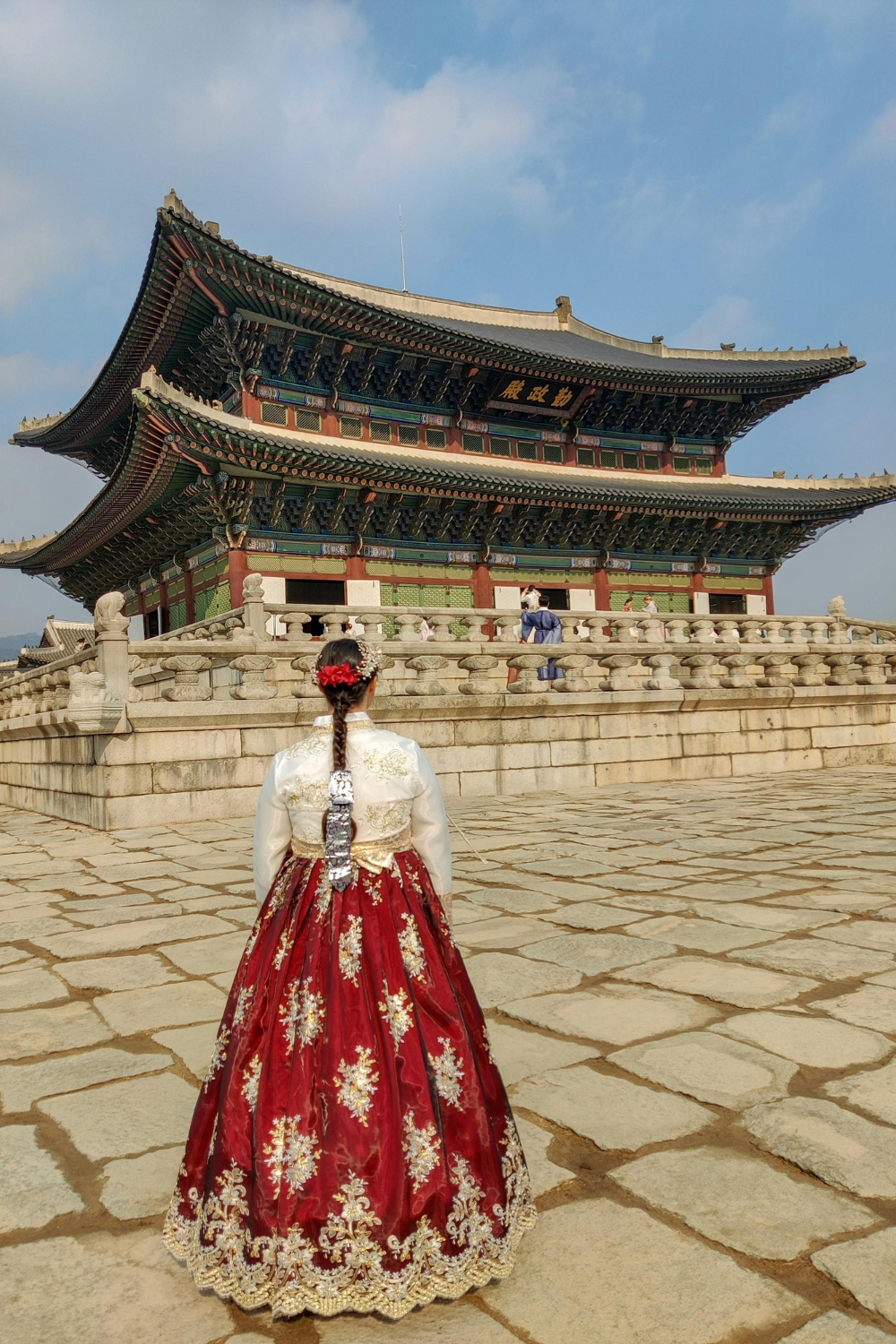
Gyeongbokgung Palace, built in 1395, serves as Seoul’s most magnificent example of traditional Korean architecture and royal history. As the largest of Seoul’s Five Grand Palaces, it offers visitors an immersive journey into Korea’s Joseon Dynasty heritage.
Royal Architecture and Gardens
The palace complex spans 410,000 square meters and features over 300 buildings showcasing traditional Korean architectural principles. The throne hall, Geunjeongjeon, represents the pinnacle of Korean palace design with its intricate wooden construction and colorful dancheong paintwork.
Beautiful gardens surround the palace buildings, incorporating traditional Korean landscape design that emphasizes harmony between nature and architecture. The famous Gyeonghoeru Pavilion sits on an artificial island in a lotus pond, creating picture-perfect reflections that change with the seasons.
Changing of the Guard Ceremony
The colorful Changing of the Guard ceremony takes place several times daily at the main gate, Gwanghwamun. This authentic recreation of Joseon Dynasty protocols features guards in traditional costumes performing ceremonial duties with historical precision.
The ceremony includes traditional Korean music, martial arts demonstrations, and elaborate costume displays that transport visitors back to Korea’s royal past. Photography is encouraged, making this one of Seoul’s most Instagram-worthy cultural experiences.
Best time to visit: Morning for ceremony, autumn for gardens
Duration: 2-3 hours
Entry fee: 3,000 KRW for adults
Ceremony times: 10:00, 14:00, 15:30 (closed Tuesdays)
2. Myeongdong Shopping District – Retail Paradise
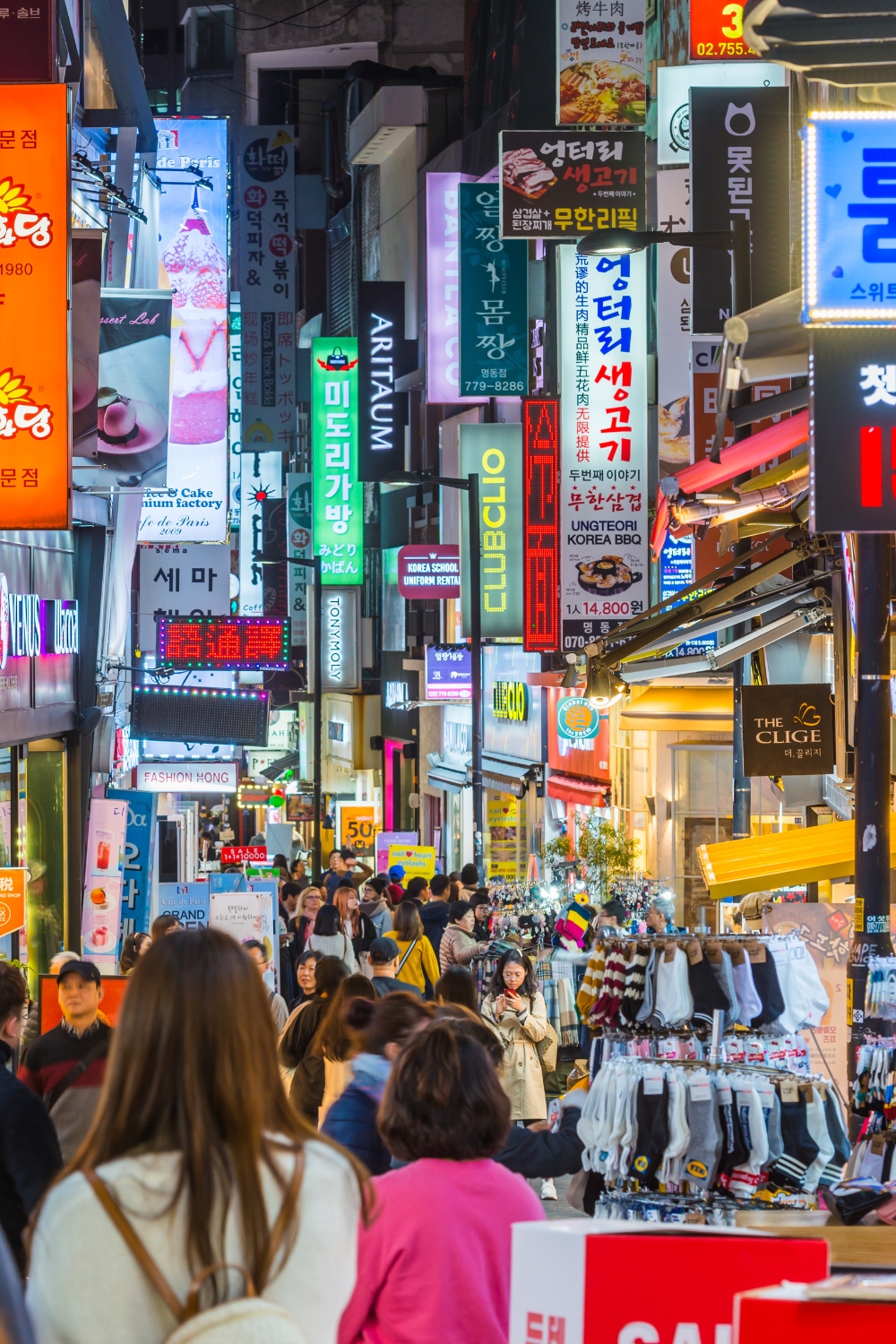
Myeongdong represents Seoul’s premier shopping destination, attracting millions of visitors annually with its incredible variety of retail options, street food, and beauty products. This pedestrian-friendly district embodies Seoul’s reputation as a shopping capital.
K-Beauty and Fashion Capital
Myeongdong serves as the epicenter of Korea’s beauty industry, featuring flagship stores from Korean cosmetic giants like Etude House, Innisfree, and The Face Shop. International visitors can discover the latest K-beauty trends and purchase products often unavailable in their home countries.
Fashion boutiques range from affordable Korean brands to international luxury labels. The district’s compact layout makes it easy to compare prices and styles while discovering unique Korean fashion trends that influence global style.
Street Food and Dining
Myeongdong’s streets come alive with food vendors selling Korean street food favorites. Must-try items include hotteok (sweet pancakes), tteokbokki (spicy rice cakes), Korean corn dogs, and fresh-grilled squid.
The district also features numerous restaurants serving both traditional Korean cuisine and international food. From high-end Korean barbecue to casual dining options, Myeongdong caters to every taste and budget.
Best for: Shopping, beauty products, street food
Peak hours: Evenings and weekends
Language: English widely spoken
Payment: Cash and cards accepted
3. Bukchon Hanok Village – Traditional Seoul
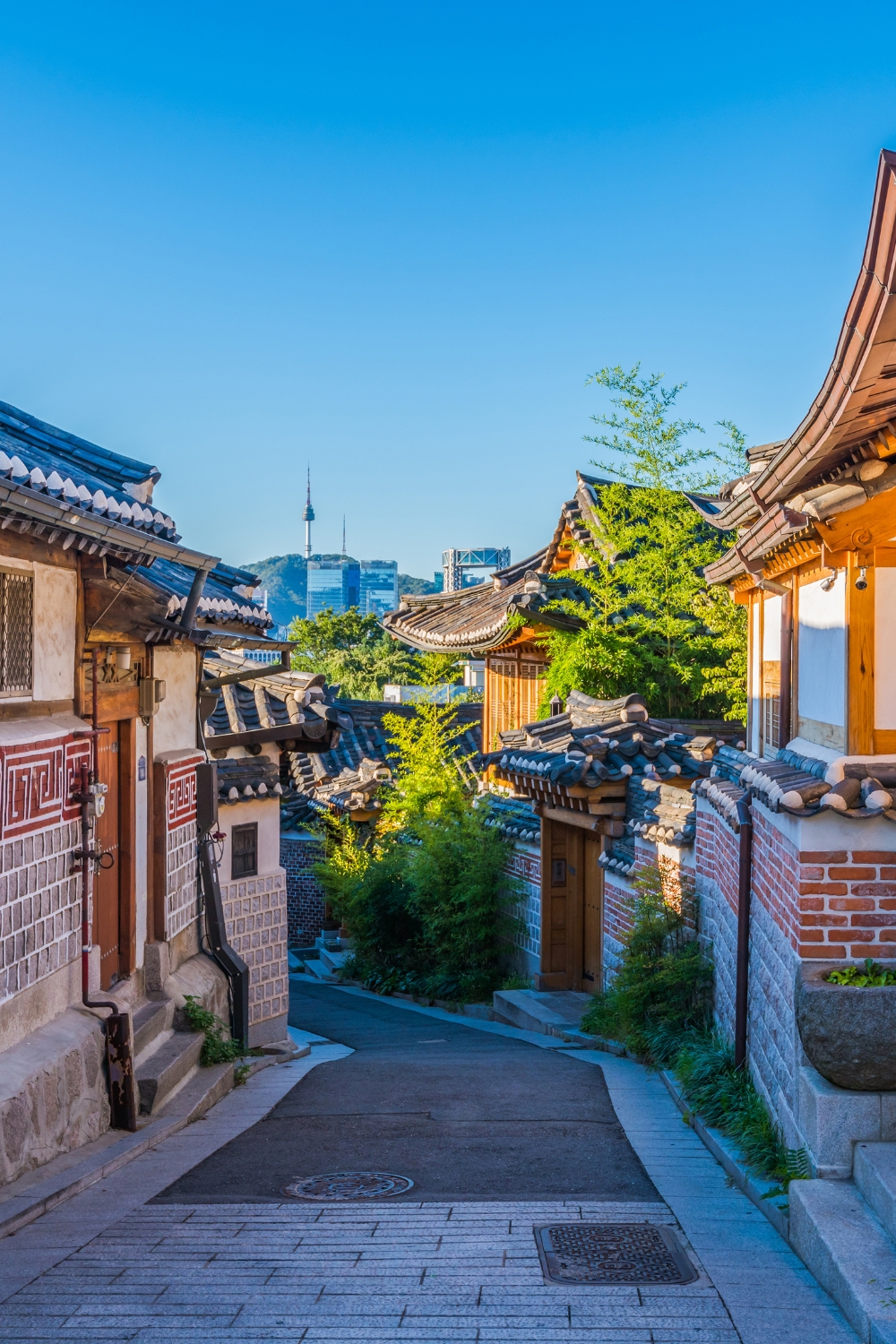
Bukchon Hanok Village preserves Seoul’s traditional residential architecture, offering visitors a glimpse into how wealthy families lived during the Joseon Dynasty. This living museum features hundreds of traditional Korean houses (hanoks) that are still inhabited today.
Traditional Architecture and Culture
The village showcases authentic hanok architecture with its characteristic curved rooflines, wooden structures, and interior courtyards. These buildings demonstrate traditional Korean construction techniques that emphasized harmony with natural surroundings.
Many hanoks have been converted into cultural centers, tea houses, and museums where visitors can experience traditional Korean crafts like pottery, calligraphy, and traditional clothing (hanbok). Some offer hands-on workshops for deeper cultural immersion.
Photography and Scenic Views
Bukchon’s narrow alleys and traditional rooflines create stunning photography opportunities, especially when contrasted with Seoul’s modern skyline visible in the distance. The village offers several designated viewpoints that provide panoramic views over the hanok rooftops.
The best lighting occurs during golden hour when the traditional architecture is bathed in warm light. However, visitors should be respectful of residents’ privacy and follow photography guidelines posted throughout the village.
Best time: Early morning or late afternoon
Photography: Designated areas only
Respect: Active residential area
Duration: 2-3 hours exploring
4. Hongdae District – Youth Culture Hub
Hongdae represents Seoul’s youthful energy and creative spirit, centered around Hongik University’s artistic community. This vibrant district pulses with student life, indie music, street art, and Korea’s most dynamic nightlife scene.
Nightlife and Entertainment
Hongdae’s nightlife scene is legendary, featuring everything from intimate jazz clubs to massive dance clubs that stay open until dawn. The district’s clubs and bars cater to diverse musical tastes, from K-pop and electronic music to indie rock and hip-hop.
Street performers entertain crowds throughout the evening, creating an outdoor festival atmosphere. The area’s compact layout makes bar hopping easy, and the student population keeps prices relatively affordable compared to other Seoul districts.
Street Art and Creative Culture
The district serves as Seoul’s street art capital, with colorful murals, graffiti, and installations decorating buildings throughout the area. This artistic expression reflects Korea’s growing creative industries and youth culture.
Independent shops sell unique fashion, handmade crafts, and artistic creations that can’t be found elsewhere in Seoul. The area’s creative energy has made it a hub for emerging artists, designers, and musicians.
Best for: Nightlife, young travelers, art enthusiasts
Peak times: Weekends after 8 PM
Age range: 20s-30s predominant
Safety: Generally safe, stay aware in crowded areas
5. N Seoul Tower – Panoramic Views

N Seoul Tower, perched atop Namsan Mountain, offers Seoul’s most spectacular panoramic views and serves as one of the city’s most recognizable landmarks. This 236-meter communications tower has become a symbol of Seoul’s modernity and romance.
Observation Decks and City Views
The tower’s observation decks provide 360-degree views of Seoul’s sprawling urban landscape, allowing visitors to appreciate the city’s massive scale and geographic setting. On clear days, visibility extends to the surrounding mountains and Han River.
Interactive displays help visitors identify landmarks and neighborhoods spread across the city below. The views are particularly stunning during sunset when the city transforms from daylight to the glittering night illumination.
Romantic Destination and Love Locks
N Seoul Tower has become Seoul’s premier romantic destination, famous for its “Locks of Love” tradition where couples attach padlocks to the tower’s fences as symbols of eternal love. The practice has created colorful displays that add to the tower’s romantic atmosphere.
The tower features romantic restaurants, cafes, and gift shops that cater to couples. Evening visits are especially popular for romantic dinners with city views and nighttime photography.
Access: Cable car or hiking trail
Best times: Sunset, clear weather
Romance factor: Very high
Reservations: Recommended for restaurants
6. Gangnam District – Modern Seoul
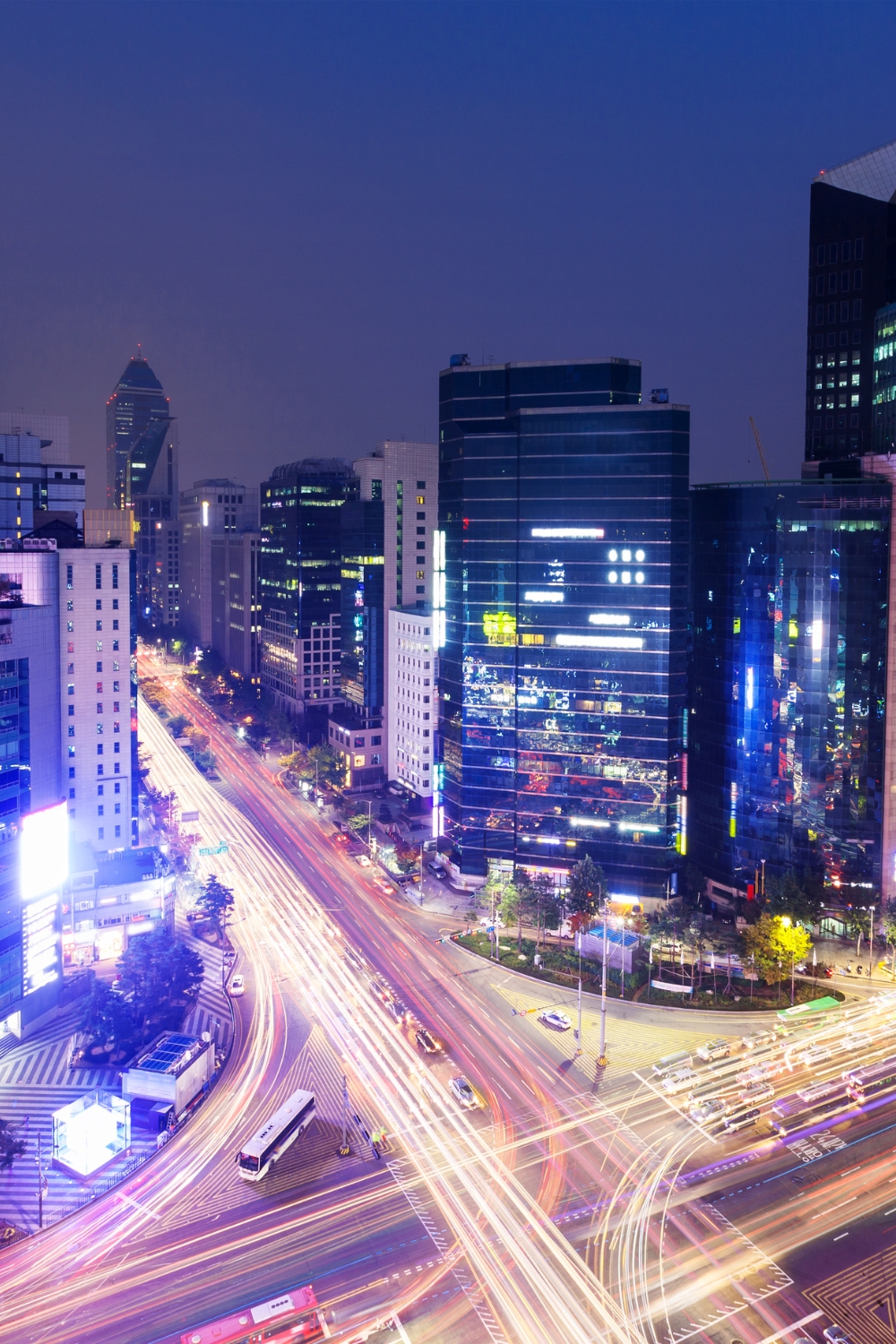
Gangnam District represents Seoul’s affluent, modern face and gained international fame through Psy’s “Gangnam Style.” This upscale area showcases Korea’s economic success through luxury shopping, high-end dining, and impressive architecture.
Luxury Shopping and Dining
Gangnam features Seoul’s most exclusive shopping centers, including COEX Mall (Asia’s largest underground shopping complex) and luxury department stores like Galleria. These venues offer high-end Korean and international brands in sophisticated settings.
The district’s dining scene includes some of Seoul’s finest restaurants, from Michelin-starred establishments to exclusive Korean barbecue restaurants. The area’s affluent clientele supports innovative cuisine and premium ingredients.
Entertainment and Business Culture
Gangnam’s entertainment venues cater to Seoul’s business elite and international visitors. Luxury karaoke rooms (noraebang), exclusive clubs, and rooftop bars provide entertainment options that reflect the district’s upscale character.
The area also serves as Seoul’s primary business district, with numerous corporate headquarters and modern office buildings creating an impressive urban skyline. The district’s infrastructure showcases Korea’s technological advancement and urban planning expertise.
Best for: Luxury experiences, business travelers
Budget: Higher than other districts
Dress code: More formal than other areas
Language: English commonly spoken
7. Dongdaemun Design Plaza – Architectural Marvel
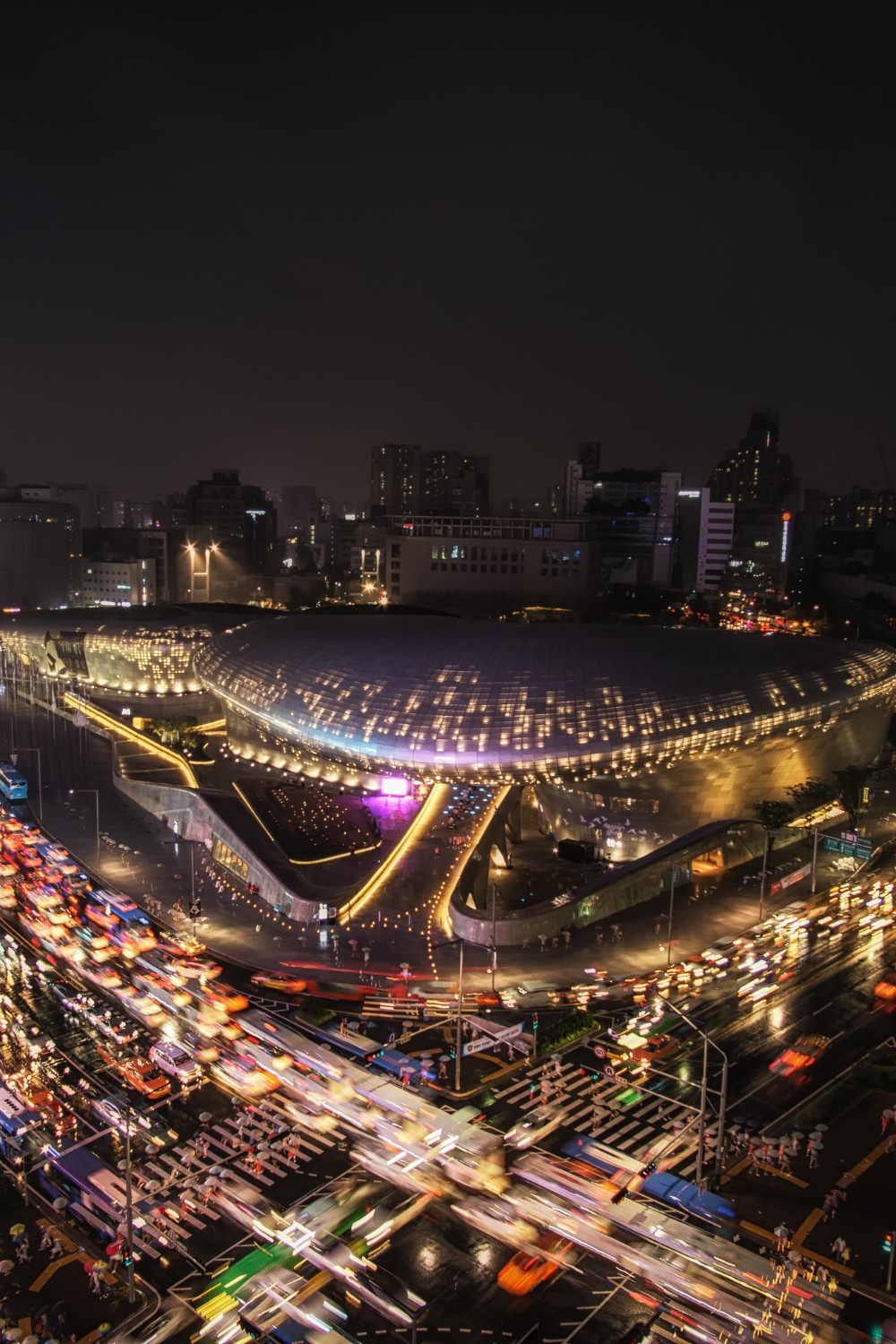
Dongdaemun Design Plaza (DDP) represents Seoul’s commitment to contemporary architecture and design innovation. This futuristic complex, designed by Zaha Hadid, serves as a cultural hub for fashion, design, and technology.
Futuristic Architecture and Design
The building’s flowing, organic curves and metallic exterior create a striking contrast with Seoul’s traditional architecture. The structure incorporates advanced LED lighting systems that create spectacular nighttime displays visible throughout the city.
Interior spaces feature cutting-edge exhibition halls, conference facilities, and design studios that showcase Korea’s growing influence in global design trends. The building itself has become a destination for architecture enthusiasts worldwide.
Fashion and Design Culture
DDP hosts fashion shows, design exhibitions, and cultural events that highlight Korea’s creative industries. The complex connects to Dongdaemun’s massive fashion wholesale markets, creating a comprehensive fashion destination.
The plaza’s design museum and galleries feature both Korean and international designers, providing insight into global design trends and Korea’s cultural contributions to contemporary arts.
Opening hours: 24 hours (some facilities vary)
Best photography: Evening LED displays
Exhibitions: Rotating schedule
Access: Dongdaemun History & Culture Park Station
8. Insadong Cultural District – Traditional Arts
Insadong preserves and celebrates Korea’s traditional arts and crafts in the heart of modern Seoul. This cultural district features traditional tea houses, art galleries, and craft shops that showcase Korea’s artistic heritage.
Traditional Crafts and Antiques
Insadong’s shops specialize in traditional Korean crafts including pottery, calligraphy, traditional paintings, and wooden crafts. Many items are created by contemporary artisans using traditional techniques passed down through generations.
Antique shops offer genuine Korean artifacts, vintage items, and historical pieces that provide insight into Korean daily life throughout different periods. Knowledgeable shopkeepers can explain the cultural significance of various items.
Tea Culture and Traditional Dining
Traditional Korean tea houses offer authentic tea ceremonies and traditional Korean teas in settings that transport visitors to Korea’s past. These establishments provide peaceful respites from Seoul’s urban energy.
Restaurants in Insadong specialize in traditional Korean cuisine served in traditional settings. Many offer vegetarian temple food, traditional court cuisine, and regional specialties that are difficult to find elsewhere in Seoul.
Best for: Cultural immersion, traditional arts
Atmosphere: Peaceful, traditional
Shopping: Unique Korean crafts
Dining: Traditional Korean cuisine
9. Han River Parks – Urban Nature

The Han River and its surrounding parks provide Seoul residents and visitors with essential green space and recreational opportunities. These waterfront areas offer relief from urban density while providing various activities and scenic beauty.
Recreational Activities and Sports
Han River parks feature extensive bicycle paths, jogging trails, and sports facilities that are popular with locals and tourists. Bicycle rentals are available throughout the park system, making it easy to explore different sections of the riverfront.
The parks host various festivals and events throughout the year, including music festivals, food festivals, and cultural celebrations. These events provide opportunities to experience Korean community life and seasonal traditions.
Scenic Beauty and Relaxation
The river provides scenic views of Seoul’s skyline from a different perspective, with numerous bridges creating architectural interest. Evening visits offer spectacular sunset views and city lights reflecting on the water.
Picnic areas and riverside restaurants allow visitors to enjoy meals with river views. The parks are especially popular during cherry blossom season and autumn when the trees create spectacular color displays.
Activities: Cycling, jogging, picnicking
Best seasons: Spring and autumn
Rentals: Bicycles available
Events: Check seasonal schedules
10. Itaewon International District – Global Seoul
Itaewon represents Seoul’s international character, featuring diverse restaurants, international shopping, and a multicultural atmosphere that attracts both expats and Korean locals seeking global experiences.
International Cuisine and Culture
Itaewon offers Seoul’s most diverse dining scene, with authentic restaurants representing cuisines from around the world. From Mexican and Indian to Turkish and Nigerian, the district provides international food options that are difficult to find elsewhere in Seoul.
The area’s international character creates a unique cultural blend where Korean and foreign influences merge. This diversity makes Itaewon particularly welcoming for international visitors who might feel overwhelmed by language barriers in other districts.
Shopping and Nightlife
The district features international brands, custom tailoring services, and unique boutiques that cater to diverse tastes. Many shops offer English-speaking staff and international sizing, making shopping more accessible for foreign visitors.
Itaewon’s nightlife scene caters to international tastes with diverse bars, clubs, and entertainment venues. The area’s multicultural character creates a unique nightlife experience that differs from traditional Korean entertainment districts.
Best for: International visitors, diverse dining
Languages: English widely spoken
Atmosphere: Multicultural, welcoming
Safety: Generally safe, tourist-friendly
Planning Your Seoul Adventure
Getting Around Seoul
Seoul’s subway system ranks among the world’s best, with extensive coverage, clear English signage, and affordable fares. The T-money card provides convenient access to subways, buses, and even some taxis throughout the metropolitan area.
Taxis are readily available and relatively affordable, though traffic can be heavy during peak hours. Many taxi drivers use translation apps, and ride-sharing apps like Kakao T offer English interfaces for easier communication.
Best Time to Visit
Spring (March-May): Cherry blossoms and mild weather create ideal conditions for outdoor activities and sightseeing. This peak season brings crowds but beautiful scenery.
Summer (June-August): Hot and humid weather with occasional monsoons. Indoor attractions like shopping centers and museums provide air-conditioned relief.
Autumn (September-November): Comfortable temperatures and stunning fall foliage make this the best time for outdoor exploration and photography.
Winter (December-February): Cold temperatures but fewer crowds and potential snow create a different Seoul experience. Indoor attractions and hot food become more appealing.
Cultural Considerations and Etiquette
Korean culture emphasizes respect and courtesy. Learning basic Korean phrases like “hello” (annyeonghaseyo) and “thank you” (gamsahabnida) demonstrates cultural respect and often receives positive responses.
Bowing is still common in formal situations, and removing shoes when entering homes or some traditional establishments is expected. Tipping is not customary in Korea, and can sometimes be considered rude.
Conclusion
Seoul offers an extraordinary urban experience that seamlessly blends ancient traditions with cutting-edge modernity. From the royal grandeur of Gyeongbokgung Palace to the futuristic architecture of Dongdaemun Design Plaza, from the traditional crafts of Insadong to the international flavors of Itaewon, each destination reveals different facets of this remarkable city.
What makes Seoul truly special is its ability to satisfy diverse interests within a single metropolitan area. History enthusiasts can explore centuries-old palaces and traditional villages. Shopping lovers can discover everything from luxury brands to unique Korean fashion. Food adventurers can experience authentic Korean cuisine alongside international flavors. Culture seekers can immerse themselves in both traditional arts and contemporary K-pop phenomena.
These ten must-visit places represent Seoul’s incredible diversity, but they’re just the beginning of what this dynamic city offers. Seoul’s efficient transportation system makes it possible to experience multiple neighborhoods and attractions in a single day, while the city’s 24/7 energy ensures there’s always something happening.
Whether you’re drawn by Korean pop culture, interested in traditional Asian culture, seeking urban adventures, or simply wanting to experience one of Asia’s most dynamic cities, Seoul delivers experiences that will exceed your expectations. The city’s combination of cultural depth, technological innovation, culinary excellence, and warm hospitality makes it an essential destination for any traveler exploring East Asia.
Start planning your Seoul adventure today, and prepare to discover why this remarkable city has become one of the world’s most exciting travel destinations. The bustling streets of Seoul await with experiences and memories that will last a lifetime.
